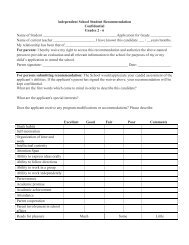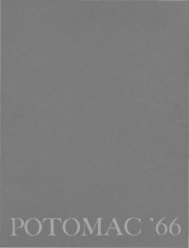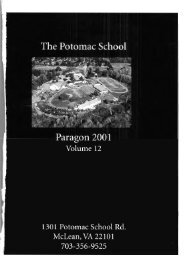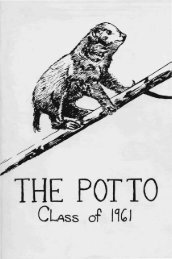Active Learning In Chemistry Education - Potomac School
Active Learning In Chemistry Education - Potomac School
Active Learning In Chemistry Education - Potomac School
Create successful ePaper yourself
Turn your PDF publications into a flip-book with our unique Google optimized e-Paper software.
It is helpful to note that in an aldehyde the carbonyl carbon is always a terminal carbon, which means it<br />
always occurs at one end of the carbon chain. <strong>In</strong> ketones, the carbonyl carbon is never a terminal carbon.<br />
The nomenclature of aldehydes requires a few rule modifications:<br />
Additional Rules for the Nomenclature of Aldehydes:<br />
RULE 1: The longest continuous chain containing the aldehyde group is considered to be the parent<br />
compound.<br />
RULE 2: The carbonyl carbon is part of the parent chain and is always considered to be in the #1 position.<br />
RULE 3: The suffix "al" is added to the name of the parent compound to indicate that the compound is an<br />
aldehyde.<br />
Note the examples of aldehydes shown below. You see that no number is needed to indicate the<br />
position of the functional group since it is always at position #1.<br />
CH3–CH2<br />
H<br />
C O<br />
CH3<br />
CH3–CH–CH2–CH2<br />
H<br />
C O<br />
propanal<br />
4–methylpentanal<br />
H<br />
O<br />
C<br />
CH2–CH3 CH3<br />
CH2–CH2–CH2–CH–CH2–CH2–CH–CH2–CH3<br />
5–ethyl–8–methyldecanal<br />
The nomenclature of ketones also requires a few rule modifications.<br />
Additional Rules for the Nomenclature of Ketones:<br />
RULE 1: The longest continuous chain containing the ketone group is considered to be the parent<br />
compound.<br />
RULE 2: A number is included before the name of the parent compound to indicate the position of the<br />
ketone group. The chain is always numbered so that the carbonyl carbon has the lowest<br />
possible number.<br />
RULE 3: The suffix "one" is added to the name of the parent compound to indicate that the compound is<br />
a ketone.<br />
For example:<br />
O<br />
O<br />
CH3<br />
C<br />
CH3<br />
CH3 CH2 C CH2 CH3–CH–CH2–CH2–CH2–C O<br />
CH3<br />
CH3<br />
CH3<br />
2–propanone 3–pentanone 6–methyl–2–heptanone<br />
26–7 ©1997, A.J. Girondi













